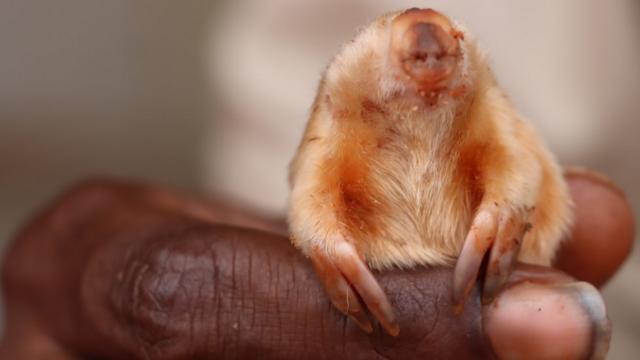Northern marsupial mole: Rare blind creature photographed in Australian outback
A remarkably rare, sightless, and furry mole has been sighted and captured on camera in the remote regions of the Australian outback.
Known as the northern marsupial mole, or kakarratul, this elusive creature inhabits one of the nation’s most isolated areas, its population size remaining a mystery to authorities.
These palm-sized creatures boast a unique appearance with their silky golden fur, lack of eyes, stubby tails, and flipper-like hands. Encounters with these marsupial moles are exceedingly rare, happening only a handful of times each decade.
This particular mole was discovered by Kanyirninpa Jukurrpa Martu rangers—indigenous custodians who utilize their traditional and local wisdom to care for their territory—while conducting their duties in the Great Sandy Desert, approximately 1,500 km (932 miles) from Perth.
Desert wildlife expert Gareth Catt highlights the enigmatic nature of these creatures, noting that most people remain unaware of their existence. He recounts an anecdote of someone mistaking a marsupial mole for a baby guinea pig, underscoring the lack of awareness surrounding them.
These burrowing animals reside within dunes in isolated deserts, spending minimal time above ground. To study them, researchers employ trench-digging and channel-creating techniques to locate their underground lairs.
Given the scarcity of information about this cryptic creature, the recent sighting—marking the second in six months—generates considerable excitement.
People often think “there isn’t a lot of life in the desert”, Mr Catt says, but it is full of unique animals. From bilbies with their giant heat-releasing ears to great thorny devils – which use their spikes to channel water into their mouths – many have developed quirks that help them cope in the harsh environment.
“A lot of wildlife in a desert if you spotted it out of context, and you didn’t know what it was, it would look very unusual,” he says.
Newly discovered beetle almost mistaken for bird poo
Many of these animals are under-researched, Mr Catt says, and further study of them is essential for ensuring their conservation in the face of climate change.
“At the most extreme ends of the environment, it becomes really obvious when things change – that’s what we’re seeing in the desert.”
“So that does put extra pressure on animals which are really living at the limits.”



